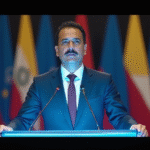Background on Key Figures and Context
Donald Trump, the President of the United States, recently met with Cyril Ramaphosa, the President of South Africa, at the White House. During this official encounter, Trump displayed a video and press clippings he claimed supported his assertion that the South African government, under Ramaphosa’s leadership, was allowing a genocide against white farmers.
Cyril Ramaphosa, a prominent figure in South African politics, has been the country’s president since 2018. He succeeded Jacob Zuma and has been working to address historical inequalities resulting from white minority rule. In February 2018, Ramaphosa was elected as the president of the African National Congress (ANC), South Africa’s ruling party, further solidifying his position as a key leader in the nation.
Elon Musk, an influential entrepreneur and multimillionaire of South African origin, was also present during the meeting in the Oval Office. Musk is known for his ventures in Tesla, SpaceX, and Neuralink, among others. His South African roots have made him a subject of interest in U.S.-South Africa relations.
The Meeting and Trump’s Allegations
Trump requested the lights to be dimmed so that a video could be projected onto a screen, claiming it showed South African black politicians inciting persecution against white farmers. He stated, “They let them take land and when they take the land, they kill the white farmer. When they kill the white farmer, nothing happens to them.”
Trump also presented press clippings he believed supported his claims, although one of them featured a picture from the Democratic Republic of Congo.
Ramaphosa firmly denied the allegations, stating, “No, no, no, no. Nobody can take land.” He attempted to address Trump’s concerns multiple times during the video presentation, but Trump interrupted him.
The Video Content
The video featured Julius Malema, a South African opposition legislator from the far-left Economic Freedom Fighters (EFF) party, singing “kill the boer,” a song from the apartheid era that targeted white farmers.
The video concluded with a protest in South Africa, where white crosses were placed along a path to symbolize the deaths of farmers. However, Trump incorrectly stated that these crosses represented their graves.
Ramaphosa’s Diplomatic Efforts
The meeting with Ramaphosa aimed to improve U.S.-South Africa relations, which had been strained by Trump and Musk’s unfounded genocide claims. Ramaphosa brought along prominent South African figures, including golfers Ernie Els and Retief Goosen, as well as billionaire Johann Rupert, all white men.
Ramaphosa emphasized the importance of dialogue, referencing Nelson Mandela’s teachings on addressing problems through conversation. He pleaded, “Let’s talk about this matter with calm.”
Key Questions and Answers
- What was the purpose of Trump’s meeting with Ramaphosa? The primary goal was to address and potentially improve strained U.S.-South Africa relations following unfounded genocide allegations made by Trump and his advisor Elon Musk.
- What did Trump claim in the video presentation? Trump presented a video and press clippings alleging that the South African government, under Ramaphosa’s leadership, was allowing a genocide against white farmers.
- How did Ramaphosa respond to Trump’s allegations? Ramaphosa denied the claims, stating that no one could take land from white farmers and emphasizing the importance of dialogue to address any concerns.
- What was the content of the video shown by Trump? The video featured Julius Malema singing “kill the boer,” a song from the apartheid era, and ended with a protest in South Africa where white crosses symbolized the deaths of farmers.






